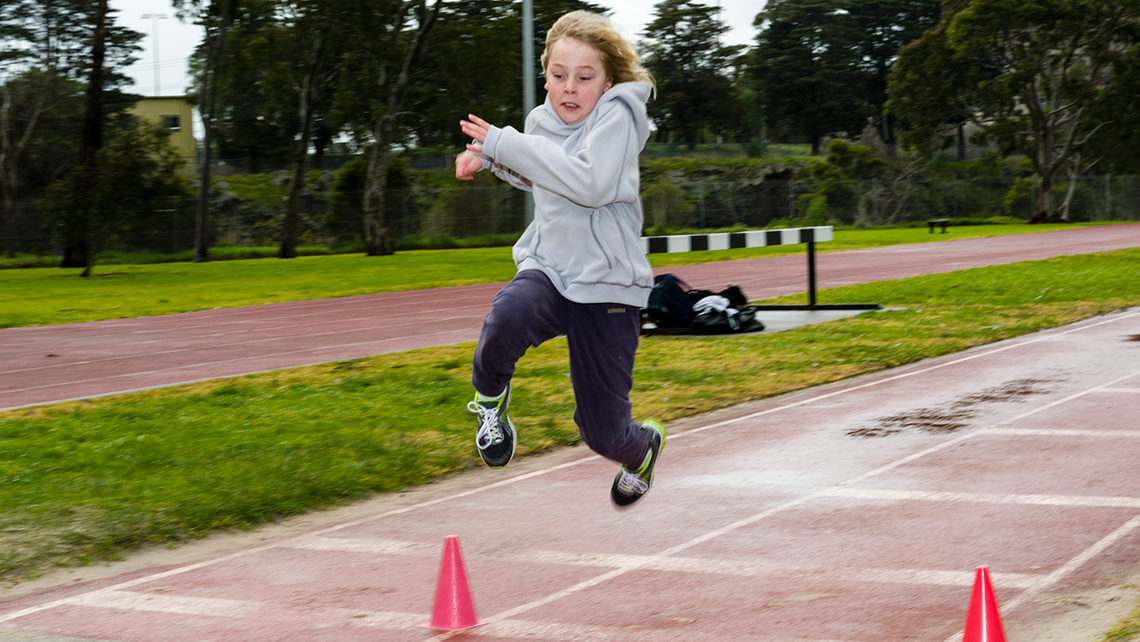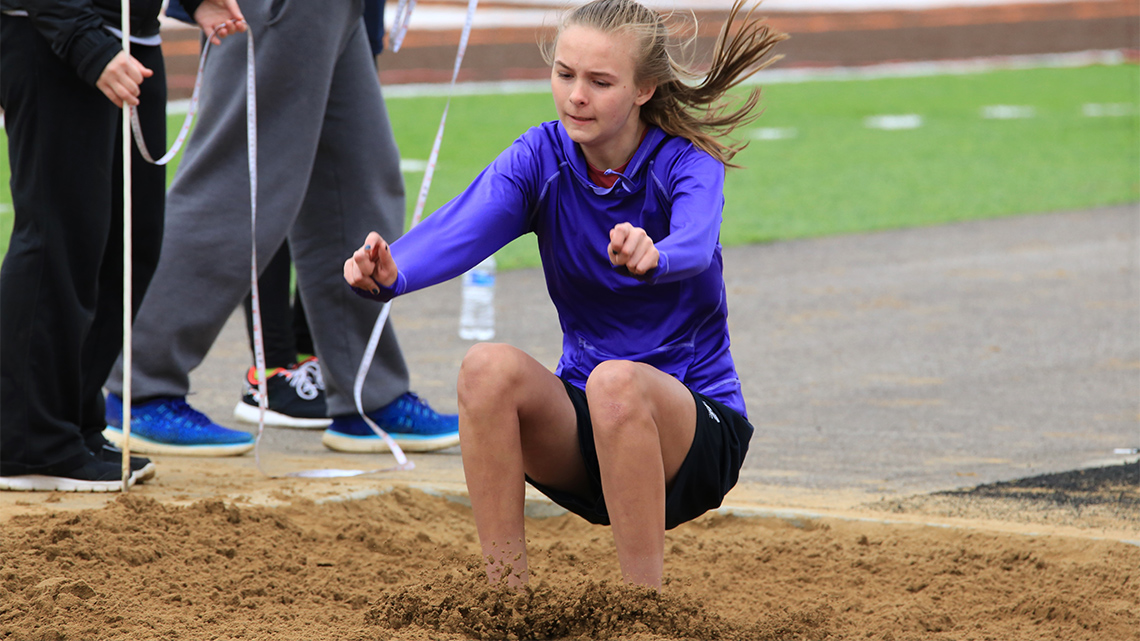Minds On
How do we jump and land?

Explore the following video to learn more about performing a running long jump.
A person is running down a long track. At the edge of a sandpit, the person jumps high off one foot, launching their body mid-air across the sandpit. The person lands with both feet in the sandpit.
What did you notice about this action? Record your ideas using a method of your choice.
Now that you have reflected on what you noticed, describe how you would break down the steps of the action to explain it to someone. What would you include?
Action
Running long jump
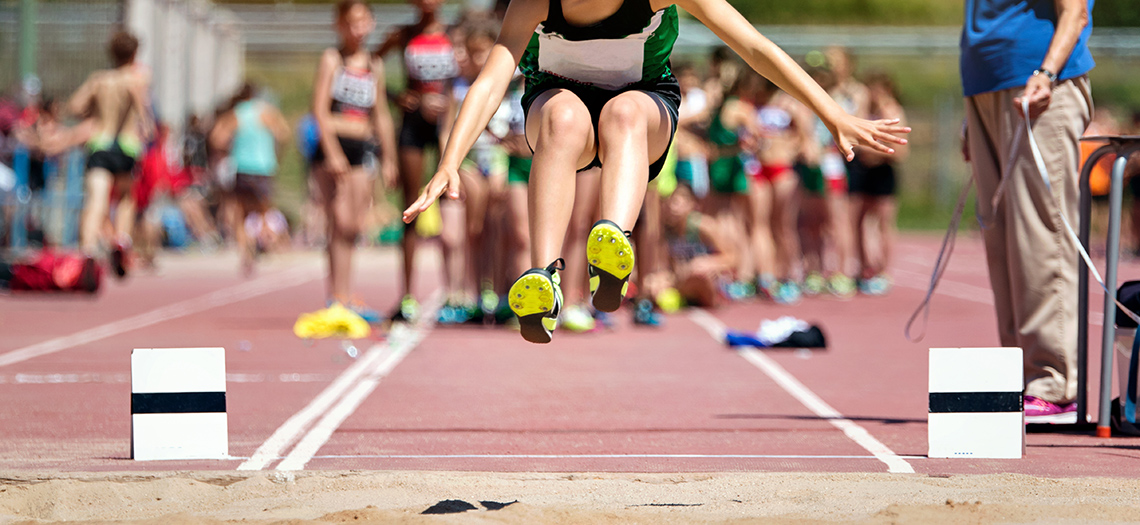
The running long jump is a sport in track and field. It consists of jumping horizontally to record the greatest total distance possible. The running long jump has been an event in the Olympic Games since 1896.
The person jumping gets a running start of about 100 feet before the jump is attempted. A takeoff board, at the end of these 100 feet, represents the area where the runner must perform their jump.
Source: Encyclopedia Britannica, 2016
What is jumping?
A jump is considered a movement that involves taking off and landing with two feet. The movement includes a takeoff, a flight, and a landing phase.
Explore the following examples to learn more about each stage of a jump.
Jumping and landing is a skill that we use in many different activities. We will explore many strategies and activities to help practise and control our jumping and landing skills.
Safety
Before you begin, consider these safety precautions:
Warm Up
Warm up
Your body needs to be warmed up before you exercise. You can do this by completing the following stretches and light aerobic exercises, which will help you better perform a movement or activity while also greatly reducing your chance of injury.
Always warm up before doing any physical activity!
Press the following tabs to learn how to perform a few warm-up activities.

If you can, let’s stretch our necks! This stretch can be performed standing up or in a seated position. Keep your shoulders relaxed as you begin with your head facing forwards. Gently and slowly tilt your head to the right. Hold here for five seconds. Begin rolling your head slowly, keeping your chin tucked and head down, to the opposite side. Hold for five seconds. Roll your neck back to the middle, then bring your head up to the starting position. Repeat 3-5 times.

If you can, let’s warm up our shoulders! Either standing or in a seated position, raise and extend your arms to the sides without bending the elbows. If you are standing, have your feet shoulder-width apart. Keep your thumbs pointing in front of you. Begin slowly rotating your arms forward, making small circles. Go forward for 20-30 seconds, then backwards for the same amount of time.

If possible, stand tall and shift your weight to your right leg. Lift your left foot back and hold it with your left hand. Pull the left foot towards your butt and feel the stretch. Hold the stretch for 20 seconds and repeat with the right leg. Repeat the stretch five times for each leg.

Stand or sit upright with your hands to your sides and lift one leg slightly up to make small circles with your ankles. Do this 10 times in each direction and repeat with your other foot.

Stand or sit upright with your hands in front of your chest. Hold one wrist with the other hand and make small circles with the wrist that is being held. Complete this 10 times in each direction and repeat with your other hand.

Begin in a standing position with your legs together and your arms at your sides. Stretch your arms above your head and jump slightly so that your feet are spread wider than shoulder-length. Repeat this movement 10 times.
Choosing your dominant foot
It’s important to determine which foot you will perform your takeoff with. Begin by reflecting on which foot you would use to kick a ball. If the answer is your right foot, then your opposite leg is your dominant and strongest side. You want to use this leg’s power to start your jump.
Student Tips
Which is dominant?
You can also determine your dominant side by asking yourself which arm you would throw a ball with. In general, a right-handed long jumper takes off with the left foot.
Trying it out

You can test your dominant side by completing a short approach jump:
- Find an open space.
- Use a piece of tape, rolled up socks, or another safe object and mark the point you’ll start your jump.
- Set up behind the marker and take two steps towards it.
- On the third step, use your dominant leg to jump.
- Complete steps 3 and 4, but this time, use your non-dominant leg.
Here is another way you can complete this activity:
- Find an open space.
- Use a piece of tape, rolled up socks, or another safe object and mark the point you’ll start your jump.
- Set up behind the marker, in a crouched position or with your legs on the ground.
- Begin by winding your dominant arm back and forth.
- On the third swing, use the momentum of your arm to carry you forward and over the line.
- Complete steps 3 to 5, but this time, use your non-dominant arm.
Pause and Reflect
Let's review
After completing this activity, reflect on the following:
- Which side of your body was your dominant side?
- How did changing your leg or arm influence your ability to perform a jump? Why is this important for attempting the movement?
Learning the running long jump
There are various steps to completing a successful running long jump. You may notice these are similar to the steps of performing a jump, with the addition of an approach run.
Press the following tabs to access the steps to perform a running long jump.

Stride as fast as you can, trying to gain and hold your speed until your reach the takeoff spot.

As you plant the takeoff foot, throw your opposite arm back and lift your chin and hips as you push off the board. Your arms and free leg shoud move upward.

When in the air, the idea is to maintain forward momentum without letting your upper body rotate forward and throw you off balance. Your takeoff leg stays back, with your non-takeoff leg pointed forward and your arms high.

Try to land feet first, with your feet stretched as far in front of you as possible, without any other part of your body touching the area behind the original mark.
Source: LiveAbout, 2019
Attempting a running long jump
You can now try a running long jump yourself!
Make sure you have about three metres of open space around you. If possible, have a parent, sibling, or friend assist you in measuring the total distance of your jump.
If possible, the long jump should be done with the following equipment:
- tape measure (if you don’t have a tape measure, you can measure your distance using your footsteps or other object)
- chalk or tape
It should be done in an environment that includes:
- a non-slip surface
- even ground
- a soft landing area
Remember to perform your safety check before you begin.
Option 1: Trying a long jump
Press the following tabs to explore one way to complete this activity.
Use tape, chalk, or another method of your choice to mark your takeoff line. You may have a peer/adult assist you.
Start about 10–16 strides away from your takeoff line.

Attempt jumping from your takeoff line as you hit your maximum running speed.
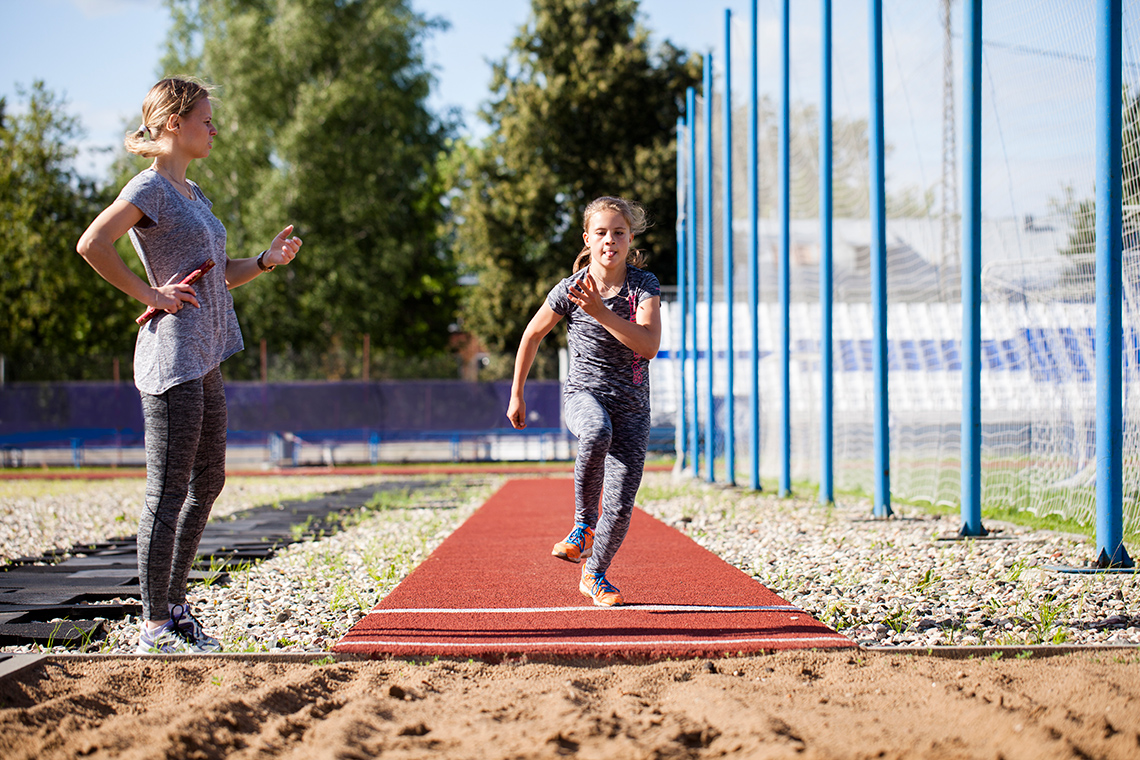
Measure the distance from where your feet landed to the takeoff line.
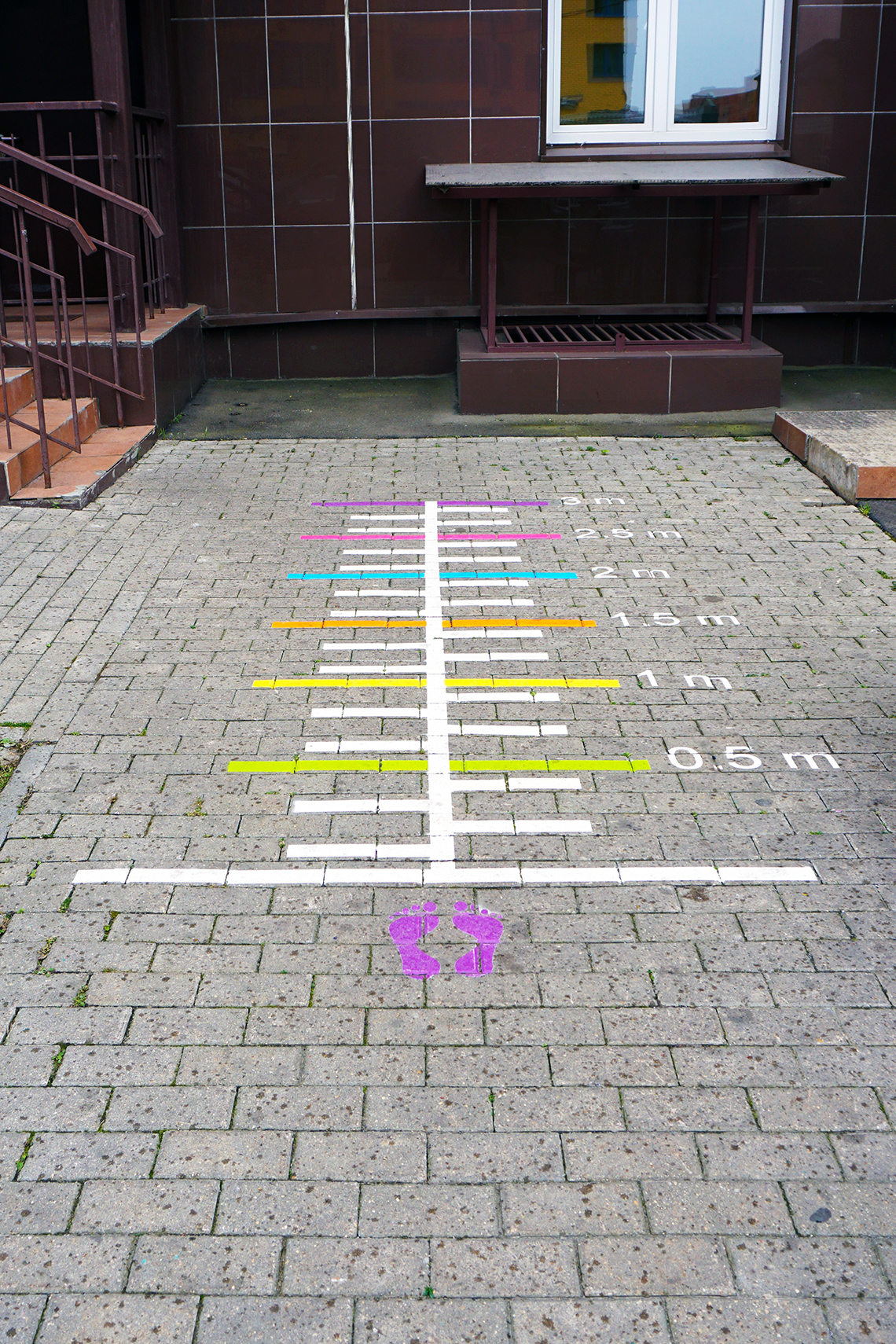
Begin by doing a few practice jumps.
When you feel ready, complete the following Standing Long Jump Recorder to record the distance of your next three jumps in your notebook or using the following fillable and printable document. If you would like, you can use speech-to-text or audio recording tools to record your thoughts.
|
Jump # |
Distance (Metres and centimetres) |
|---|---|
|
1. |
|
|
2. |
|
|
3. |
Press the ‘Activity’ button to access Standing Long Jump Recorder.
Pause and Reflect
Questions
- Were you able to increase your distance after each jump?
- Did your body position during the “flight” phase affect your jump distance?
- Why do you think so?
Record your answers in a notebook or a method of your choice.
Option 2: Sidewalk long jump
Press the following tabs to access the modified steps for performing a long jump.
Draw a series of circles on the sidewalk using sidewalk chalk.

Jump from circle to circle without falling out of the lines.

Record how many attempts it took before you missed a circle.

Test Your Skills
Challenge
For an extra challenge, try increasing the distance between circles depending on the length of the sidewalk!
Cool Down
Let’s stretch!
We’ll cool down with a few stretches. Remember to take slow and deep breaths during these stretches to allow your heart rate to return to a normal pace.
Explore the following images for ways to stretch and cool down.
Consolidation
What makes a long jump?
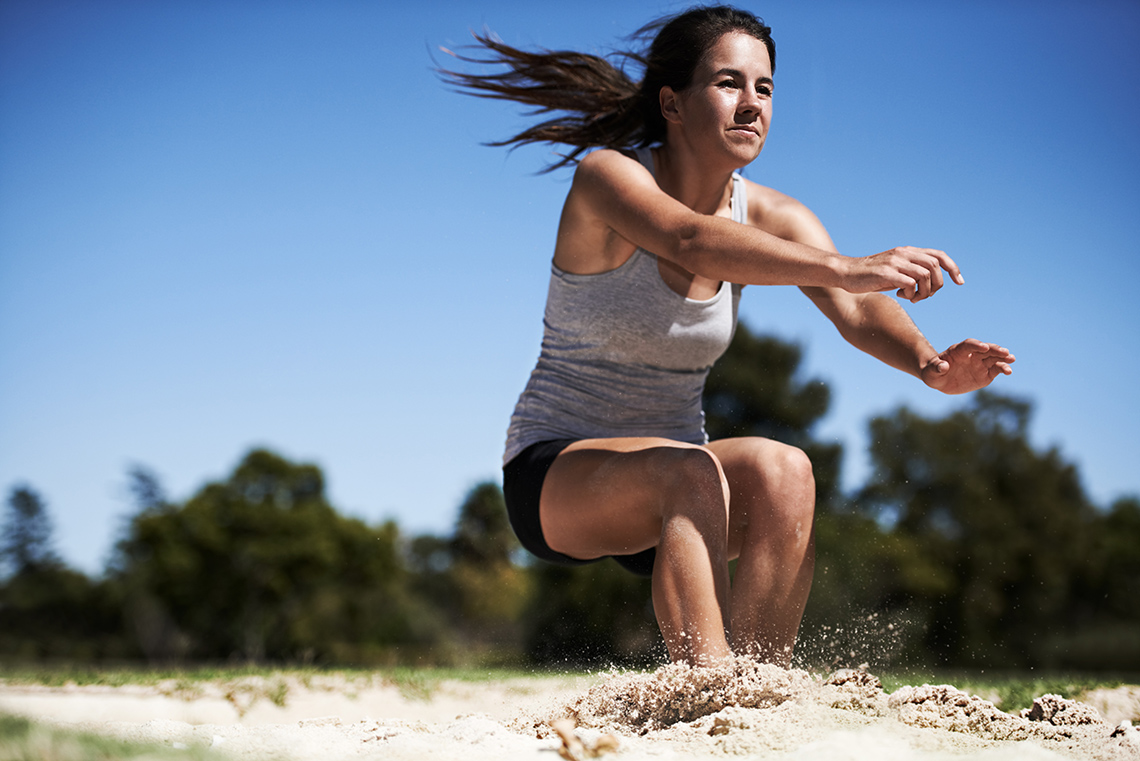
Let’s review the different steps of a long jump by exploring the following activity.
For each stage, select the corresponding image.
Match the long jump stages
What’s the order?
Now that you’ve matched the action to each part of the long jump, let’s organize the movements in the right order.
For each sentence, select the missing phrase from the options below.
Let's review
Answer the following questions in the method of your choice.
What do I need to do in order to complete a long jump successfully or jump in control for distance?
Reflection
How do you feel about what you have learned in this activity? Which of the next four sentences best matches how you are feeling about your learning? Press the button that is beside this sentence.
I feel…
Now, record your ideas about your feelings using a voice recorder, speech-to-text, or writing tool.
